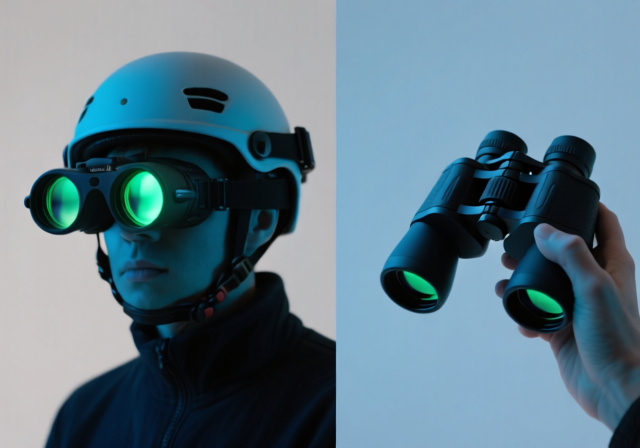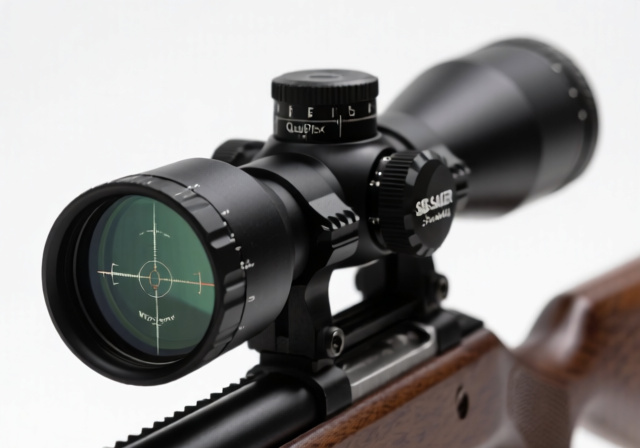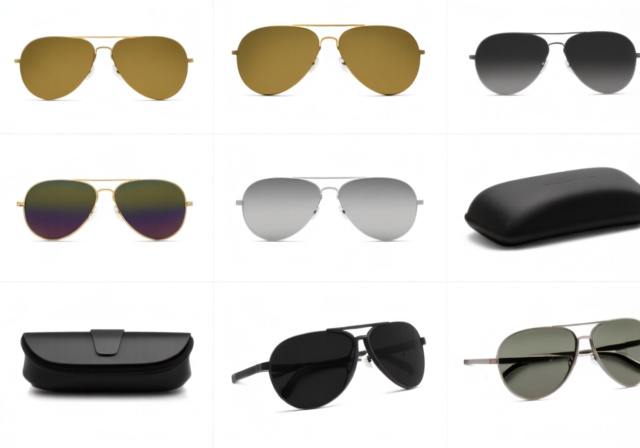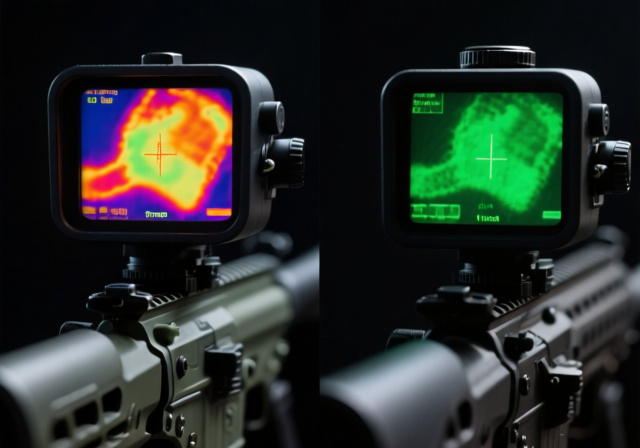

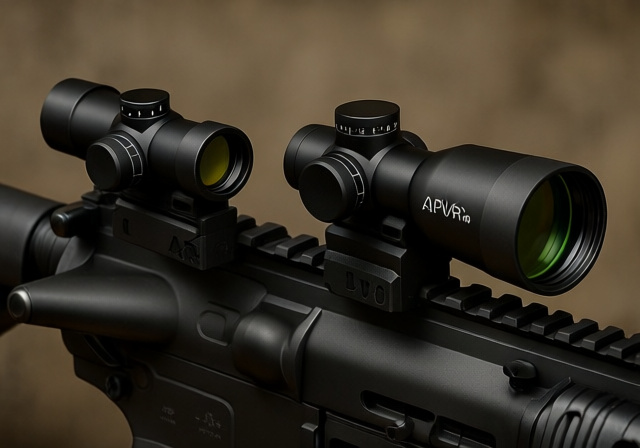

Choosing between a prism scope and an LPVO can make or break your shooting experience. After testing dozens of optics and spending countless hours on ranges with both systems, I can tell you that each has its place – but only one is right for your specific needs.
Prism scopes offer fixed magnification with battery-independent operation and compact size, while LPVOs provide variable magnification versatility for engaging targets at different distances. The best choice depends entirely on your intended use, budget, and rifle platform.
In this comprehensive comparison, we’ll break down every aspect of these two popular optic types, from technical specifications to real-world performance, helping you make an informed decision without the marketing hype.
Whether you’re setting up a home defense AR-15, building a competition rifle, or outfitting a hunting rig, understanding the strengths and limitations of each optic type will save you money and frustration in the long run.
| Feature | Prism Scopes | LPVOs |
|---|---|---|
| Magnification | Fixed (1x-5x typical) | Variable (1-4x to 1-10x) |
| Reticle Visibility | Etched, always visible | Wire/etched, may need battery |
| Eye Relief | Longer, more forgiving | Varies with magnification |
| Weight | Lighter (8-12 oz) | Heavier (14-24 oz) |
| Battery Dependency | None for basic reticle | Required for illumination |
| Best For | Fixed distance shooting | Variable distance scenarios |
Prism scopes are fixed magnification optics that use prismatic lenses instead of traditional lens arrangements found in conventional scopes. What makes them unique is the etched reticle – a physical marking on glass that remains visible even without battery power.
Unlike red dot sights that project a dot onto a lens, prism scopes bounce light through internal prisms to create a clear image with an integrated reticle. This design makes them particularly effective for shooters with astigmatism who often see distorted or starburst patterns with red dots.
Most prism scopes come in 1x, 3x, or 5x configurations, with 1x models being popular for close-quarters work and 3x-5x variants excelling at intermediate ranges. The fixed magnification isn’t a limitation but rather a deliberate design choice that prioritizes simplicity and durability.
Key features that set prism scopes apart include etched reticles with ranging marks, built-in mounting solutions (often included), and illumination systems that enhance reticle visibility in low light without being essential for operation. Many shooters appreciate the “always on” nature of the reticle – no batteries needed means no failure when you need it most.
For those interested in learning more about different optic technologies, our complete guide to optical instruments provides deeper insights into how various sight systems work.
LPVO stands for Low Power Variable Optic, and these scopes have revolutionized the rifle optics market by offering true 1x magnification at the low end while extending to 4x, 6x, 8x, or even 10x at the high end. This versatility makes them incredibly popular across multiple applications.
At 1x, an LPVO functions essentially like a red dot, allowing for fast, both-eyes-open shooting. Crank the magnification dial, and you suddenly have the capability to identify and engage targets at 300-600 yards depending on the configuration. This dual nature eliminates the need for multiple optics or magnifiers.
Modern LPVOs come with either first focal plane (FFP) or second focal plane (SFP) reticles. FFP reticles scale with magnification, making holdovers accurate at any power, while SFP reticles remain the same size and are typically calibrated for a specific magnification setting. Our detailed comparison of FFP vs SFP reticles can help you decide which is better for your needs.
The trade-off for this versatility comes in weight and complexity. LPVOs are inherently heavier than prism scopes due to more complex internal mechanisms. They also typically require separate mounting solutions and have more moving parts that could potentially fail under extreme conditions.
Despite these considerations, the ability to transition from close-quarters engagements to medium-range precision without changing optics or adding accessories makes LPVOs the go-to choice for competition shooters, hunters, and tactical operators who face varied engagement distances.
LPVOs clearly win on versatility with their variable magnification ranges. A 1-6x LPVO can handle everything from room-clearing distances to shots across a canyon. This flexibility is invaluable in competition stages where targets might appear at 7 yards and then immediately at 300 yards.
Prism scopes, however, offer simplicity with their fixed magnification. A 3x prism excels at 50-300 yard engagements where you know your typical engagement distance. The lack of moving parts means fewer things can go wrong, and there’s no need to adjust power during high-stress situations.
This is where prism scopes often shine. Most prism scopes offer generous eye relief of 3-4 inches with a forgiving eye box that allows for consistent sight picture even if your head position isn’t perfect. This makes them ideal for dynamic shooting situations where you can’t always achieve perfect cheek weld.
LPVOs typically have 3.5-4 inches of eye relief at 1x, but this can decrease significantly at higher magnifications. The eye box also becomes more critical as magnification increases, requiring more consistent head position for a full sight picture.
⚠️ Important: LPVO eye relief varies with magnification. Always check the specific model’s eye relief at maximum power if you plan to shoot at higher magnifications frequently.
Prism scopes generally win on weight and compactness. Most weigh between 8-12 ounces and have a shorter overall length, making them ideal for lightweight builds or rifles where balance is crucial. The compact size also means they sit lower on the rifle, reducing the need for risers or cheek risers.
LPVOs are typically heavier, ranging from 14-24 ounces depending on magnification range and construction. The additional weight comes from more complex internal mechanics and often larger objective lenses. While this weight penalty is manageable on full-sized rifles, it can significantly affect the balance of lightweight or pistol caliber carbines.
Prism scopes have a distinct advantage here – the etched reticle is always visible without power. Illumination, when available, typically runs for 1,000-5,000 hours on a single CR2032 battery, but even with a dead battery, the optic remains fully functional.
LPVOs require battery power for illuminated reticles, and while battery life has improved dramatically (many now exceed 1,000 hours on medium settings), a dead battery means losing your reticle illumination. In daylight, most LPVO reticles remain visible without power, but in low light conditions, battery failure can render the optic difficult to use.
Both optic types can offer excellent optical quality, but they achieve it differently. Prism scopes use glass prisms that can provide edge-to-edge clarity with minimal distortion. The fixed magnification allows for optimization at a specific power, often resulting in very sharp images.
LPVOs have evolved significantly, with premium models offering exceptional glass quality across their magnification range. However, budget LPVOs may suffer from edge distortion or reduced clarity at maximum magnification. The variable nature means they’re optimized for performance across a range rather than excelling at one specific magnification.
Both systems can be incredibly durable when built to quality standards. Prism scopes, with fewer moving parts, might have a theoretical advantage in long-term reliability, but modern LPVOs from reputable manufacturers are built to withstand abuse and hold zero under heavy recoil.
The key factor here is build quality rather than optic type. A premium LPVO from a trusted brand will outlast a budget prism scope with poor construction. Look for features like aircraft-grade aluminum construction, nitrogen purging for fog proofing, and robust warranty support regardless of which type you choose.
For home defense scenarios where engagements typically occur inside 50 yards, a 1x prism scope often makes more sense than an LPVO. The fixed power eliminates the need to adjust settings under stress, and the etched reticle remains visible even if batteries die after years of storage.
The longer eye relief and forgiving eye box of prism scopes also help when shooting from unconventional positions. In high-stress situations, simplicity is your friend – and nothing is simpler than a fixed power optic that’s always ready.
LPVOs generally have the edge for hunting applications where shot distances can vary dramatically. A hunter might need to take a quick 30-yard shot at a moving deer and then a precise 250-yard shot at a stationary animal moments later.
The variable magnification allows for target identification at distance while still providing fast acquisition capability up close. However, for hunters who consistently hunt in terrain with predictable shot distances (like eastern deer hunters who rarely shoot beyond 150 yards), a fixed 3x prism scope might be perfectly adequate and lighter to carry all day.
For 3-gun and other multi-distance competitions, LPVOs dominate for good reason. The ability to transition from close targets to distant ones without changing positions or dealing with magnifier flips provides a significant time advantage.
Competitors value the versatility of a 1-6x or 1-8x LPVO that can handle everything from pistol-distance targets to 400-yard shots on the same stage. While some shooters successfully compete with fixed power optics, they’re often at a disadvantage on stages with extremely varied target distances.
Opinions are divided in the tactical community, but many operators prefer LPVOs for their dual-role capability. The ability to identify threats at distance while maintaining close-quarters capability is valuable in urban environments where threats can appear at any range.
However, some specialized units prefer the reliability and simplicity of prism scopes for specific missions where engagement distances are known and battery failure is not an option. The choice often comes down to specific mission requirements and department preferences.
For general range use and skill development, either optic type can serve well. Prism scopes are excellent for developing fundamentals at specific distances, while LPVOs allow you to practice across multiple distances without changing gear.
Budget-conscious shooters might find better value in quality prism scopes that offer reliable performance without the complexity of variable magnification. However, the training value of practicing with variable magnification shouldn’t be underestimated for those planning to advance in the sport.
When it comes to night vision compatibility, some premium prism scopes offer dedicated NV settings that won’t damage night vision devices. The etched reticle can be visible through night vision without any illumination, which is a significant advantage for nocturnal operations.
LPVOs with night vision compatibility typically feature multiple illumination settings, including ultra-low settings visible only through night vision. However, not all LPVOs offer this capability, so careful selection is crucial if night vision use is planned.
For those specifically interested in night vision compatible optics, both types offer viable options, but prism scopes often have an edge in simplicity and battery independence during nighttime operations.
Reticle options abound in both categories, with manufacturers offering BDC (Bullet Drop Compensator) reticles, Christmas tree designs with windage holds, and simple duplex reticles for those who prefer a clean sight picture. The choice often comes down to personal preference and intended use.
After comparing both optic types across multiple applications, the decision ultimately comes down to your specific needs. Here’s a simple decision framework:
For brand-specific comparisons and recommendations, our scope brand comparison provides insights into how different manufacturers approach both optic types.
The main difference is that LPVOs offer variable magnification (typically 1-4x to 1-10x) for versatile shooting at different distances, while prism scopes have fixed magnification with etched reticles visible without battery power.
Prism scopes offer several advantages: battery-independent operation with etched reticles, more forgiving eye relief, lighter weight, simpler operation with no moving parts, and often include mounting solutions.
The main limitations of prism scopes include fixed magnification (no versatility for different distances), fewer models available in the market, and being specialized for specific range applications rather than all-purpose use.
Prism scopes generally offer a more forgiving eye box with consistent eye relief across their fixed magnification, while LPVOs have good eye relief at 1x but it becomes more restrictive and critical at higher magnifications.
Prism scopes are absolutely worth it for shooters who prioritize reliability, simplicity, and operate at consistent distances. They’re especially valuable for home defense, tactical applications where battery failure is unacceptable, and shooters with astigmatism.
LPVO disadvantages include greater weight and bulk, battery dependency for illuminated reticles, more critical eye position at higher magnifications, complexity with more moving parts, and typically higher total cost when including quality mounts.
Yes, prism scopes work well for hunting, especially in areas with predictable shot distances. A 3x or 5x prism scope is excellent for deer hunting in wooded environments where shots typically stay within 200-300 yards.
No, prism scopes do not require batteries for basic operation. The etched reticle is always visible. Batteries are only needed if you want to use the illumination feature for low light conditions.
After extensive testing and real-world experience with both optic types, my recommendation comes down to this: choose a prism scope if you value simplicity, reliability, and primarily shoot at consistent distances. Choose an LPVO if you need versatility across multiple engagement distances and don’t mind the additional weight and complexity.
Both optic types have proven themselves in real-world applications from competition to combat. The “better” option is the one that matches your specific needs, rifle, and shooting style. Don’t get caught up in internet debates – focus on what will work best for your particular situation.
Remember, skill development matters more than equipment choice. A well-trained shooter with either optic type will outperform an untrained shooter with the most expensive gear. Choose the optic that fits your needs, then invest your remaining budget in training and ammunition.
For more expert testing and reviews on specific applications, check out our expert scope testing articles that provide in-depth analysis of specific models and their performance in real-world conditions.


